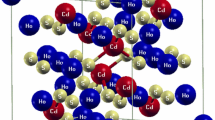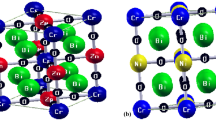Abstract
Self-consistent ab initio calculations of the structural, crystallographic, electronic, optical, and physical properties as well as spontaneous polarization of P21 (α)-ferroelectric phase of diisopropylammonium bromide (α-DIPAB) molecular crystal are carried out. Examination of the total density of states as obtained using the generalized gradient approximation and hybrid exchange–correlation functional (HSE06) methods yields an optical bandgap of ∼ 5 eV and 6 eV, respectively. Furthermore, by using the Berry phase approach, we found that polar DIPAB exhibits a spontaneous polarization of 22.64 μC/cm2, indicating that this remarkable ferroelectric molecule could be used as an alternative to replace several known ferroelectrics for piezoelectric and optoelectronic applications such as capacitors, sensors, and data storage as well as microelectromechanical system (MEMS) devices. Using the vdW + DF2 approximation, we identify the majority of the vibrational modes in the Raman spectra and analyze the modes generated by the bromine (Br) deficiency. We find that the Br deficiency strongly affects the electric and elastic properties of α-DIPAB. Furthermore, the elastic, dielectric, and piezoelectric tensors of α-DIPAB are calculated and interpreted. α-DIPAB is found to exhibit a static dielectric tensor of ∼ 2.5, i.e., slightly smaller than that of typical perovskite-based ferroelectrics. In addition, the clamped-ion piezoelectric tensor is calculated. We found that the piezoelectric coefficient e21 corresponding to applying uniaxial strain in the direction perpendicular to the N–C bonds is smaller than the e22 principle coefficient. Moreover, the components e15 = 0.220 C/m2 and e35 = −0.2032 C/m2 correspond to applying shear strain η31, indicating a reasonable piezoelectric response of this polar crystal and making it a cheap attractive candidate for piezoelectric applications. The components of the elastic moduli tensor are calculated and interpreted. The α-DIPAB exhibits Young’s modulus of up to 50 GPa along specific crystalline directions despite its relatively low hardness. We attribute such a large value to the presence of a dense H–Br bond network between the Br and DIPAB molecule. The Poisson ratio is also strongly anisotropic, with values ranging from 0.5 to 0.2. The DIPAB systems are brittle based on the ratio between the bulk and shear elastic constants, suggesting that this material has potential for use in flexible electronic applications. A real-part dielectric anomaly at T = 140 K induced by iodine doping of α-DIPAB exhibits switchable behavior. This abnormality can be attributed to suppression of ferroelectricity induced by trapping of vortices at dislocation defects generated by iodine. Another dielectric anomaly found in the vicinity of the Curie temperature of α-DIPAB can be explained in terms of a structural phase-induced ferroelectric-to-paraelectric transition.
Similar content being viewed by others
References
N. Luo, S. Zhang, Q. Li, C. Xu, Z. Yang, Q. Yan, Y. Zhang, and T. Shrout, ACS Appl. Mater. Interfaces 8, 15506 (2016).
C. Hu, H. Tian, X. Meng, G. Shi, W. Cao, and Z. Zhou, RSC Adv. 7, 7003 (2017).
S. Zhang and F. Li, J. Appl. Phys. 111, 031301 (2012).
M.-Q. Cai, Z. Yin, M.-S. Zhang, and Y.-Z. Li, Chem. Phys. Lett. 401, 4 (2005).
F.-Z. Yao, Q. Yu, K. Wang, Q. Li, and J.-F. Li, RSC Adv. 4, 20062 (2014).
D. Pang and Z. Yi, RSC Adv. 7, 19448–19456 (2017).
J. Scott, Science 315, 954 (2007).
M.E. Lines and A.M. Glass, Principles and Applications of Ferroelectrics and Related Materials (Oxford: Oxford University Press, 2001).
S. Horiuchi and Y. Tokura, Nat. Mater. 7, 357 (2008).
L.E. Cross, Ferroelectrics 76, 241 (1987).
A. Piecha, A. Gągor, R. Jakubas, and P. Szklarz, Cryst. Eng. Commun. 15, 5 (2013).
J. Li, Y. Liu, Y. Zhang, H.-L. Cai, and R.-G. Xiong, Phys. Chem. Chem. Phys. 15, 48 (2013).
C.R. Bowen, J. Taylor, E. LeBoulbar, D. Zabek, A. Chauhan, and R. Vaish, Energy Environ. Sci. 7, 12 (2014).
H.-Y. Ye, Y. Zhang, S.-I. Noro, K. Kubo, M. Yoshitake, Z.-Q. Liu, H.-L. Cai, D.-W. Fu, H. Yoshikawa, K. Awaga, R.-G. Xiong, and T. Nakamura, Sci. Rep. 3, 2249 (2013).
K. Gao, M. Gu, X. Qiu, X. Ying, H.-Y. Ye, Y. Zhang, J. Sun, X. Meng, F.M. Zhang, D. Wu, H.-L. Cai, and X. Wu, J. Mater. Chem. C 2, 46 (2014).
D.W. Fu, W. Zhang, H.L. Cai, J.Z. Ge, Y. Zhang, and R.G. Xiong, Adv. Mater. 23, 5658–5662 (2011).
D.-W. Fu, H.-L. Cai, Y. Liu, Q. Ye, W. Zhang, Y. Zhang, X.-Y. Chen, G. Giovannetti, M. Capone, J. Li, and R.-G. Xiong, Science 339, 425–428 (2013).
Q. Ye, Y.-M. Song, G.-X. Wang, K. Chen, D.-W. Fu, P.W. HongChan, J.-S. Zhu, S. Huang, and R.-G. Xiong, J. Am. Chem. Soc. 128, 6554–6555 (2006).
H.-Y. Ye, D.-W. Fu, Y. Zhang, W. Zhang, R.-G. Xiong, and S.D. Huang, J. Am. Chem. Soc. 131, 42–43 (2008).
D. Mao, I. Mejia, H. Stiegler, B. Gnade, and M. Quevedo-Lopez, J. Appl. Phys. 108, 094102 (2010).
J. Valasek, Phys. Rev. 17, 475 (1921).
J. Valasek, Phys. Rev. 19, 478 (1922).
J. Valasek, Phys. Rev. 20, 639 (1922).
J. Valasek, Phys. Rev. 24, 560 (1924).
R. King-Smith and D. Vanderbilt, Phys. Rev. B 47, 1651 (1993).
P. Hohenberg and W. Kohn, Phys. Rev. 136, B864 (1964).
J.P. Perdew, J. Chevary, S. Vosko, K.A. Jackson, M.R. Pederson, D. Singh, and C. Fiolhais, Phys. Rev. B 48, 4978 (1993).
D.A. Bonnell, Science 339, 401–402 (2013).
A. Alsaad, N. Al-Aqtash, R. Sabirianov, A. Ahmad, Q.M. Al-Albataineh, I. Qattan, and Z. Albataineh, Front. Phys. 7, 203 (2019).
A. Alsaad, N. Al-Aqtash, and R. Sabirianov, APS March Meeting Abstract (2015).
A. Alsaad, C.M. Marin, N. Alaqtash, H.-W. Chao, T.-H. Chang, C.L. Cheung, A. Ahmad, I.A. Qattan, and R. Sabirianov, Data Brief 16, 667–684 (2018).
A. Alsaad, I.A. Qattan, A. Ahmad, N. Al-Aqtash, and R. Sabirianov, J. Phys: Conf. Ser. 92, 1 (2015).
A. Alsaad, C.M. Marin, N. Alaqtash, H.-W. Chao, T.-H. Chang, C.L. Cheung, A. Ahmad, I.A. Qattan, and R. Sabirianov, J. Phys. Chem. Solids 113, 82–85 (2018).
G. Giovannetti, C. Ortix, M. Marsman, M. Capone, J. Van Den Brink, and J. Lorenzana, Nat. Commun. 2, 1–6 (2011).
J.P. Perdew, J.A. Chevary, S.H. Vosko, K.A. Jackson, M.R. Pederson, D.J. Singh, and C. Fiolhais, Phys. Rev. B 46, 6671 (1992).
G. Kresse and D. Joubert, Phys. Rev. B 59, 1758 (1999).
J.P. Perdew, K. Burke, and M. Ernzerhof, Phys. Rev. Lett. 78, 3865 (1996).
J. Perdew, K. Burke, and M. Ernzerhof, Phys. Rev. Lett. 80, 891 (1998).
J. Heyd and G.E. Scuseria, J. Chem. Phys. 120, 7274–7280 (2004).
J. Heyd, G.E. Scuseria, and M. Ernzerhof, J. Chem. Phys. 118, 8207 (2003).
A.V. Krukau, O.A. Vydrov, A.F. Izmaylov, and G.E. Scuseria, J. Chem. Phys. 125, 1063 (2006).
M. Dion, H. Rydberg, E. Schröder, D.C. Langreth, and B.I. Lundqvist, Phys. Rev. Lett. 92, 246401 (2004).
K. Lee, É.D. Murray, L. Kong, B.I. Lundqvist, and D.C. Langreth, Phys. Rev. B 82, 081101 (2010).
J. Klimeš, D.R. Bowler, and A. Michaelides, Phys. Rev. B 83, 13 (2011).
A. Puzder, M. Dion, and D.C. Langreth, J. Chem. Phys. 124, 164105 (2006).
G. Kresseand and D. Joubert, Phys. Rev. B 59, 1758 (1999).
K. Berland, V.R. Cooper, K. Lee, E. Schröder, T. Thonhauser, P. Hyldgaard, and B. Lundqvist, Rep. Prog. Phys. 78, 066501 (2015).
A.J. Lovinger, Science 220, 1115–1121 (1983).
J.H. Lee, L. Fang, E. Vlahos, X. Ke, Y.W. Jung, L.F. Kourkoutis, J.-W. Kim, P. Ryan, T. Heeg, M. Roeckerath, V. Goian, M. Bernhagen, R. Uecker, P. Hammel, K. Rabe, S. Kamba, J. Schubert, J. Freeland, D. Muller, C. Fennie, P. Schiffer, V. Gopalan, E. Johnston-Halperin, and D. Schlom, Nature 466, 954–958 (2010).
W. Zhang and R.-G. Xiong, Chem. Rev. 112, 1163–1195 (2012).
C. Thirmal, P. Biswas, Y. Shin, T. Noh, N. Giridharan, A. Venimadhav, and P. Murugavel, J. Appl. Phys. 120, 124107 (2016).
Q.M. Al-Bataineh, A. Alsaad, A. Ahmad, and A. Al-Sawalmih, J. Electron. Mater. 48, 5028–5038 (2019).
G. Román-Pérez and J.M. Soler, Phys. Rev. Lett. 103, 096102 (2009).
J. Klimeš, D.R. Bowler, and A. Michaelides, J. Phys.: Condens. Matter 22, 022201 (2009).
G.H. Haertling, J. Am. Ceram. Soc. 82, 797–818 (1999).
P. Dowben, D. McIlroy, D. Li, and H. Phys, Chem. Rare Earth. 24, 1–46 (1997).
J. Scott, Phase Transit. 30, 107–110 (1991).
M. Emam-Ismail, M. El-Hagary, E. Shaaban, and A. Al-Hedeib, J. Alloys Compd. 532, 16–24 (2012).
C. Kittel, Introduction to Solid State Physics, 6th ed. (Tokyo: Maruzen, 1986), pp. 124–129.
J. Tauc, Amorphous and Liquid Semiconductors (Berlin: Springer, 2012).
L. Wan, T. Nishimatsu, and S. Beckman, J. Appl. Phys. 111, 104107 (2012).
J. Axe, Phys. Rev. 157, 429 (1967).
P.S.H. Ghosez, X. Gonze, and J.-P. Michenaud, Ferroelectrics 206, 205–217 (1998).
M. Grundmann, O. Stier, and D. Bimberg, Phys. Rev. B 52, 11969 (1995).
S. Schulz, M. Caro, E. O’Reilly, and O. Marquardt, Phys. Rev. B 84, 125312 (2011).
X. Gonze and C. Lee, Phys. Rev. B 55, 10355 (1997).
M.A. Caro, S. Schulz, and E.P. O’Reilly, J. Phys. Condens. Matter 25, 025803 (2012).
K. Uchino, Piezoelectric Actuators and Ultrasonic Motors, Vol. 7 (Berlin: Springer, 1996).
S. Prosandeev and L. Bellaiche, Phys. Rev. B 75, 172109 (2007).
S. Baroni, P. Giannozzi, and A. Testa, Phys. Rev. Lett. 58, 1861 (1987).
S.-E. Park, S. Wada, L. Cross, and T.R. Shrout, J. Appl. Phys. 86, 2746–2750 (1999).
O. Auciello, J.F. Scott, and R. Ramesh, Phys. Today 51, 22–27 (1998).
R. Levitskii, I. Zachek, T. Verkholyak, and A. Moina, Phys. Rev. B 67, 174112 (2003).
A. Moina, R. Levitskii, and I. Zachek, Phys. Rev. B 71, 134108 (2005).
K. Gilleo, Handbook of Flexible Circuits (Berlin: Springer, 1998).
C. Wang, D. Hwang, Z. Yu, K. Takei, J. Park, T. Chen, B. Ma, and A. Javey, Nat. Mater. 12, 899–904 (2013).
R.C. Webb, A.P. Bonifas, A. Behnaz, Y. Zhang, K.J. Yu, H. Cheng, M. Shi, Z. Bian, Z. Liu, Y.-S. Kim, W.-H. Yeo, J. Park, J. Song, Y. Li, Y. Huang, A. Gorbach, and J. Rogers, Nat. Mater. 12, 938–944 (2013).
Z. Suo, MRS Bull. 37, 218 (2012).
S. Wagner and S. Bauer, MRS Bull. 37, 207–213 (2012).
S. Wang, M. Li, J. Wu, D.-H. Kim, N. Lu, Y. Su, Z. Kang, Y. Huang, and J. Rogers, J. Appl. Mech. 79, 3 (2012).
M. Kaltenbrunner, T. Sekitani, J. Reeder, T. Yokota, K. Kuribara, T. Tokuhara, M. Drack, R. Schwödiauer, I. Graz, S. Bauer-Gogonea, S. Bauer, and T. Someya, Nature 499, 458 (2013).
A. Alsaad, N. Alaqtash, A. Al Kadhim, R.F. Sabirianov, A. Ahmad, I.A. Qattan, and M.-A. Al-Akhras, Eur. Phys. J. B 93, 5 (2020).
S.-C. Wu, G.H. Fecher, S. Shahab Naghavi, and C. Felser, J. Appl. Phys. 125, 082523 (2019).
S. Pugh, Philos. Mag. 45, 823 (1954).
W. Voight, Teubner, 962 (1928).
A. Reuss, J. Appl. Math. Mech. 9, 49–58 (1929).
D. Chung, W. Buessem, F. Vahldiek, and S. Mersol, Anisotropy in Single Crystal Refractory Compounds (New York: Plenum, 1968), p. 217.
S.I. Ranganathan and M. Ostoja-Starzewski, Phys. Rev. Lett. 101, 055504 (2008).
G. Kaige, Z. Binbin, C. Yunqing, and C. Xiaobing, R. Soc. Open Sci. 5, 181397 (2018).
Acknowledgments
The authors gratefully acknowledge the University of Nebraska for providing computational access to the clusters at the Holland computing center. The authors acknowledge Jordan University of Science and Technology for technical and financial support and express their gratitude for the unlimited computational access provided by Holland Computing Center affiliated to the University of Nebraska/Lincoln. We acknowledge Khalifa University of Science and Technology, Abu Dhabi, UAE for generous technical and financial support.
Author information
Authors and Affiliations
Corresponding author
Ethics declarations
Conflict of Interest
The authors declare that they have no conflicts of interest.
Additional information
Publisher's Note
Springer Nature remains neutral with regard to jurisdictional claims in published maps and institutional affiliations.
Rights and permissions
About this article
Cite this article
Alsaad, A.M., Qattan, I.A., Ahmad, A.A. et al. Theoretical and Experimental Overview of Structural, Dielectric, Crystallographic, Electronic, Optical, and Physical Tensors of α-DIPAB and Iodine-Doped α-DIPAB Molecular Ferroelectric Crystals. J. Electron. Mater. 49, 7112–7132 (2020). https://doi.org/10.1007/s11664-020-08486-z
Received:
Accepted:
Published:
Issue Date:
DOI: https://doi.org/10.1007/s11664-020-08486-z




